Previously: Is “Dear David” Real? Part 1; Part 2; Part 3; Part 4.
Wondering what’s been going on lately with Adam Ellis and the alleged ghost named Dear David who’s seemingly out for his blood? Well, let’s fix that. It’s been an eventful couple of months for Ellis, and even though it’s pretty clear that the answer to the question, “Is Dear David real?” is, “Heck no” at this point, the story is still going strong — and I’m actually starting to wonder if we might be nearing the end of it all.

The last time we checked in with Ellis, it was the middle of November, and he’d just discovered that a few pictures of David he thought he’d taken in a dream had actually been taken in real life. The concrete nature of the images quashed the idea that David could be the result of pareidolia, apophenia, or just plain coincidence; he was very clearly there, and very clearly stalking Ellis. He also looked rather like a doll, which I think supports the hypothesis (which previous images had prompted) that the photos were staged, either actually using a doll, or with the help of some photo manipulation software. (Or, perhaps both.)
[Like what you read? Check out Dangerous Games To Play In The Dark, available from Chronicle Books now!]
Since I don’t think there’s much value in beating the “David is a doll or Photoshop” horse to death, I’m going to switch gears a little bit in terms of how I look at the whole thing this time round: Rather than debunking it (because there really isn’t much left to debunk), I’m going to focus on the storytelling itself. This means that we’ll be talking about the outside structure of the tale, as well as dealing with the interior logic of the world it has created. I’m fairly certain that, although I believe we’re looking at a hoax, I don’t think it’s been carried off with the intent to fool or trick people; I think it’s an exercise in unconventional storytelling. As such, examining exactly what it is about said storytelling that makes the tale so effective seems like the most productive angle to tackle.
Is it still possible that David actually is a ghost? I mean, sure — but that’s dependent on whether or not you believe in ghosts in the first place. As I’ve noted several times before, I’m a skeptic, so that’s the perspective from which I’ve been approaching the tale. You may feel differently, so take my thoughts with a grain of salt.
Anyway, in the intervening months since our last look at the saga, Ellis has given us four major updates: One on Nov. 17, one on Nov. 28, one on Dec. 12, and one on Jan. 2. Let’s get to it, shall we?
(EDIT 3/19: Part 6 is here!)
(EDIT 6/6: A “Dear David” movie has been announced.)
The Hatch
After the Nov. 6 update with that terrifying batch of pictures, we got the next installment on Nov. 17 — about a week and a half later.
It’s worth pointing out at this juncture that the update schedule has become somewhat predictable; although Ellis launched a new thread every couple of days during August, once the fall rolled around — after the story’s ongoing viral success had been firmly established — a new pattern emerged: He began posting updates roughly every week and a half to two weeks. The first time this timeframe occurred was between the Sept. 5 and Sept. 16 updates, and although the scheduled was interrupted a bit while Ellis was in Japan, he settled into the new schedule once he returned: An update came on Oct. 14; another on Oct. 26; the next on Nov. 6; and now this one on Nov. 17.
The reason I think this is notable is because of something I realized while covering the story for another outlet I write for: It’s about the length of time the public remains interested in each individual update.
The lifecycle of your average Dear David installment seems to go something like this: Ellis will tweet an update late at night; the next morning, that update will begin to circulate in the news; it will proceed to be discussed heatedly in a variety of online spaces; interest will eventually begin to die down; and then, after discussion has pretty much ceased about that update, Ellis will tweet a new one, beginning the whole cycle again.
What I see in that pattern is optimization — that is, I believe Ellis has determined exactly when he needs to post in order to get the most bang for his proverbial buck with each update. Since Ellis works in online spaces professionally, he’s almost certainly familiar with how to optimize content in such a way that it’s seen and engaged with by as many people as possible — whether that’s through SEO or through timing. Applying this sort of knowledge to the Dear David story, therefore, would definitely help out with its ongoing success. Think about it: Ellis has been running the whole thing as a serialized story for over five months. Given the internet’s notoriously short attention span, that is a remarkable length of time. It’s worthy of applause in and of itself, even without considering the actual content of the story.
Also worthy of applause is the way in which Ellis is using his surroundings to tell the story — which brings us to the meat of this particular update: He found a weird hatch in the ceiling of the hallway outside his apartment, which could end up being a game changer.
Ellis discovered the hatch as a result of some unsettling noises he had begun hearing in his apartment — or more specifically, noises he had begun hearing coming from above his apartment. The noises started, he said, while he was sitting on his couch tweeting the Nov. 6 update: “About 30 seconds after I’d sent the last tweet, I heard a thump directly above my head, as if someone above me had dropped something on the floor,” he wrote — something which he clarified was seemingly “impossible” due to several facts: He lives in the top apartment of the building, and there’s “no way to access the roof” easily. (“There aren’t any ladders on the outside of the building. The only way you’d get on the roof is through a skylight in the hallway. There are no trees in the immediate vicinity, either,” he wrote.)
You’ll recall that Ellis lives in a building that’s kind of like a duplex — it used to be a house, but now it’s two apartments, one on the ground floor and one on the second floor. When David first appeared, Ellis was living in the downstairs apartment; he began tweeting the whole saga sometime later, after David had “found” him again following Ellis’ move into the upstairs apartment.
This is relevant because it’s the context for Ellis’ understanding of the building. He assumed — reasonably, I would argue — that the building’s layout was something like this:
But it turns out that this understanding may have been incorrect. As a result of the noises, Ellis began wondering if there was “some secret crawl space in [his] home”; however, a search of his apartment revealed nothing out of the ordinary. When he went into the hallway, though, he looked up — and saw that hatch. A video showed that it’s quite high up:
And furthermore, it means that there are a few feet of space between the ceiling (where the hatch is located) and the actual roof of the building that we have no idea might hold:
His revised understanding of the building based on this revelation therefore looks like this:
The noises continued after he discovered the hatch; wrote Ellis, “A few days after I heard the first sound, I heard a similar thump while I was in the kitchen. Then last night, I heard something small clink to the floor and roll about 6 feet before stopping.” He believed “something is going on up there”; he “[couldn’t] get over the fact that the hatch is in such a weird, inaccessible place over the stairs”; and he wanted to investigate the whole thing further. He wasn’t exactly sure how to do that, since he doesn’t own a ladder of the size needed to reach the hatch from the stairs, but as a temporary solution, he ordered a telescoping pole from Amazon so he could at least poke the hatch open and look at it from below.
In any event, the next update came — you guessed it — about a week and a half later.
The Crawlspace
On Tuesday, Nov. 28 — the week following Thanksgiving, which Ellis (along with much of the workforce in the United States) had off and during which he was subsequently out of town — a new thread began. Ellis said that the noises he claimed he had begun hearing in early November hadn’t stopped; however, the pole he had ordered wasn’t delivered until after he had already left for the holiday, so he wasn’t able to investigate the hatch until after he got home. He arrived back at his apartment late on Friday, Nov. 24 to find the pole waiting for him, so he made plans to check out the hatch on Saturday morning.
He… did not sleep well that night. “I’d barely fallen asleep when I woke up to an INCREDIBLY loud crash above me,” he wrote. “It sounded like someone had dropped a bowling ball. I bolted upright in bed and immediately felt strange. There was a weird energy all around me. I can’t explain it.” More crashes came — about 15 in total — plus a “smaller, creaky sound from the hallway” he thought might have been a footstep; however, although Ellis thought about leaving right then and there, he stayed put. To leave the building, he would have had to walk under the hatch, which “seemed like a bad idea” to him, so he just… waited. The noises stopped, and eventually, he fell back asleep.
The next morning, he was on his way out the door to go get a bagel — something he does every Saturday (and, I mean, fair; New York bagels are delicious. I miss them so much) — but aborted the bagel mission when he noticed something on the stairs:
The presence of the debris prompted him to look up, where he saw this:
And that, in turn, made him run back upstairs, grab the telescoping pole, come back down, and use the pole to poke at the hatch in order to find out exactly what was stuck in there. He took a video of this part:
This is what fell out:
It’s a shoe. A child’s shoe. And, I suppose, it’s reasonable to assume it’s David’s shoe.
At this point, Ellis finally did what he should have done right from the start: He got in touch with his landlord, telling him that he thought there was something in the crawlspace. The landlord appears to have known about the crawlspace already, as Ellis didn’t report him seeming surprised about it; he just wrote, “He said he’d come by later with a ladder and check it out” — that’s all.
…Or at least, the fictionalized version of the landlord that occupies this particular role in Ellis’ story appears to have known about the crawlspace already. We don’t actually see any photos or video of the landlord; all we’ve got to go on is what Ellis is telling us happened, which may or may not be true in reality. It’s true within the framework of the story, though, so let’s just roll with it.
Anyway, Ellis said that the landlord came over with a ladder as promised, set it up, opened the hatch, and poked his head up inside. At first he didn’t see anything; after a moment, though, Ellis said he heard him say, “Oh wait.” Wrote Ellis, “I watched as he reached up into the emptiness with his free arm, and when he pulled it back he had something small and round in his hand. He climbed down the ladder and handed it to me.”
This is the object the landlord had found:
This must be what made that “clink” sound Ellis heard on Nov. 6.
When he did a little research about the marble, he discovered it’s probably an antique:
He ended the update by telling us, “Anyway, now I have a decrepit old shoe and a marble sitting on my dresser. I guess this is the new normal.” To me, this is the equivalent of Sidney Prescott’s complaint about how women in slasher flicks always run up the stairs when they’re being chased by the killer instead of running out the front door: Dudes in ghost stories should not hang onto objects discovered which might be connected to the ghost that’s haunting them; they should probably try to cleanse them, destroy them, or at least keep them somewhere other than at home.
Consider that another point towards the idea of the story as fiction. The fictional Ellis needs to keep the marble and shoe directly in his home to raise the stakes and possibly provide David with a point of entry — so even though it’s not wise to do so, and even though every ghost story that exists should have taught us not to do this, that’s what he does.
But let’s go a step further. Assuming that, yes, the story is fiction and that Ellis acquired both the shoe and the marble so he could stage this particular installment, he gets points for realism; if his plan was to date the marble to the turn of the last century, thus setting up David’s origin story as having taken place around 1900, then this is an excellent way to do it. The bump on the marble, you see, is called a pontil, and it is in fact what distinguishes a glass marble that’s been made by hand — as they would have been at the turn of the century — and one that’s been made by machine, as they are now. A pontil shows where the marble was snipped off of the molten glass rod from which it was made — a process that was carried out with the help of marbelschere, or marble scissors.
Marbelschere were invented in 1846 by a worker at a German glass factory and were used until the marble industry was mechanized. Marbles made by machine don’t have the pontils not because they aren’t snipped from molten glass rods, but because the machines are much better at smoothing down the edges than marbelschere were. According to How Product Are Made, machine-based marble manufacturing started to kick up around 1910-1911, so if the marble was David’s, then it appears he lived and died a lot earlier than most of us probably thought. He’s not a recently deceased boy; he’s a boy who suffered a terrible fate about 115 years ago.
Is anyone else curious about the history of the land on which Ellis’ apartment currently stands? Maybe there was a store there once. And maybe the accident that David said claimed his life happened in that hypothetical store.
Or maybe David is lying.
Here’s another question I have about the shoe and the marble: Were those objects already in the crawlspace before this whole thing began… or did David put them there himself? Whatever the case, there are a lot of narrative possibilities for how the story could unfold from here. Consider:
If the objects have been there this entire time, have they been there for decades? A century? Is that why David seems to be stuck in the house? How did they get up there? Did something happen to him up there in the crawlspace? If so, were the marble and shoe left behind?
If, however, David has put them there himself… when did he do it? Recently, I’d assume — but how recently? And why?
Either way, what were the noises Ellis was hearing? Was it David trying to draw his attention to the crawlspace? Did he want him to find the objects? Was this the only way he could think to make that happen?
Or, was David trying to draw up into the crawlspace itself? Was it a trap?
Or… were the noises a sort of recorded memory of something that happened up there? Was it something David did? Was it something someone else did to David? Was it the shelf that killed David falling down?
And, finally: What did Ellis do when he opened the hatch?
Did he let David out?
Whatever else might be going on, the marble is clearly connected to David; it’s green, just like the rocking chair, the chair in the warehouse, the jar on the coffee table, the turtle shell, and the knitted cactus were. Food for thought.
Little Lord Fauntelroy
A quick diversion: A few Twitter followers suggested at this point that the “real” Dear David might be Little Lord Fauntleroy, the name given to an anonymous murder victim from 1921. Found in a quarry pond in Waukesha, Wisconsin, Fauntleroy was a boy of around 5 to 7 years of age who had died of blunt force trauma. He was never satisfactorily identified, and his murder was never solved.
I don’t ascribe to this theory. I think the evidence is just too flimsy. Yes, he was wearing leather shoes when he was found, and Ellis found a leather shoe in the crawlspace; however, the shoes Fauntleroy was wearing were patent leather, while the shoe Ellis found appears to be just regular ol’ leather. (Even accounting for age and distress, the crawlspace shoe would have been much shinier if it was patent leather.) And yes, Fauntleroy was wearing good quality clothing, which suggests he may have been kidnapped from wealthy parents, and yes, David’s story is unfolding in New York, where there were and are a lot of wealthy families; however, there are also plenty of other major metro areas near Waukesha that had and still have wealthy families, two of which had leads that actually connected them to the Fauntleroy case: Milwaukee and Chicago. To say it’s “very likely” Fauntleroy was from New York, as some Twitter users have suggested, is a pretty big leap to make.
I’ve written more about this theory here, so check it out if you’re so inclined; I wouldn’t read to much into it, though. Ellis also hasn’t commented on it at all.
He Sees You When You’re Sleeping
Life pro tip: Watching someone sleep is rarely, if ever, romantic. It is creepy. And it is especially creepy if you are an angry child ghost and/or a weird-looking doll watching the person who lives in the apartment you’re haunting sleep.
That’s exactly what happened in the next update, which followed on Dec. 12. This update was a little longer in coming than the last one — two weeks on the nose — which I suspect might have been to account for Christmas and New Years’ interrupting the flow somewhat. Anyway, Ellis started — as he often does — by downplaying what’s been going on, only to ramp it up later in the thread. He hadn’t been feeling well or sleeping well, but he didn’t think it was related to Dear David… at first. Then something weird started happening: Starting the Wednesday before he began tweeting this thread (which, is my math is right would have made it the evening of Dec. 6), he said he “woke up with a start and felt something strange, like something had just been watching me.”
When he turned on the light, of course, nothing was there — but the same thing happened again the next night, and since what he was feeling was the sort of “dread” and “malice” that “always accompanies David,” he decided to do something about it. He downloaded an app to his phone that would make the device automatically take pictures every 60 seconds, set it up on his bookcase, kept the light on, and went back to sleep.
This time, when he woke up with that same start he’d experienced the other two times, he grabbed his phone and scrolled through the camera roll. There were around 350 pictures (so, he’d been asleep for not quite six hours), most of which just showed him sleeping alone in the room:
But about 100 photos in (he would have been asleep for around one and two thirds of an hour at that point), there was… this:
Here’s what that one looks like with the brightness turned up:
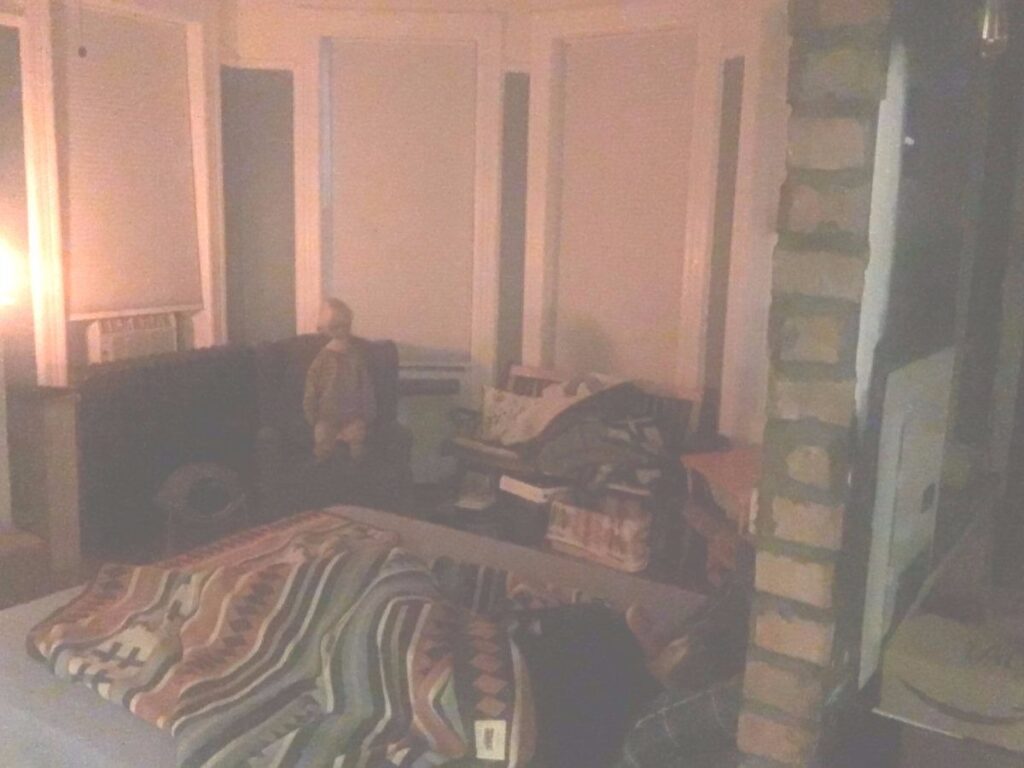
David just appeared, according to Ellis.
And then there was this:
Brightened:
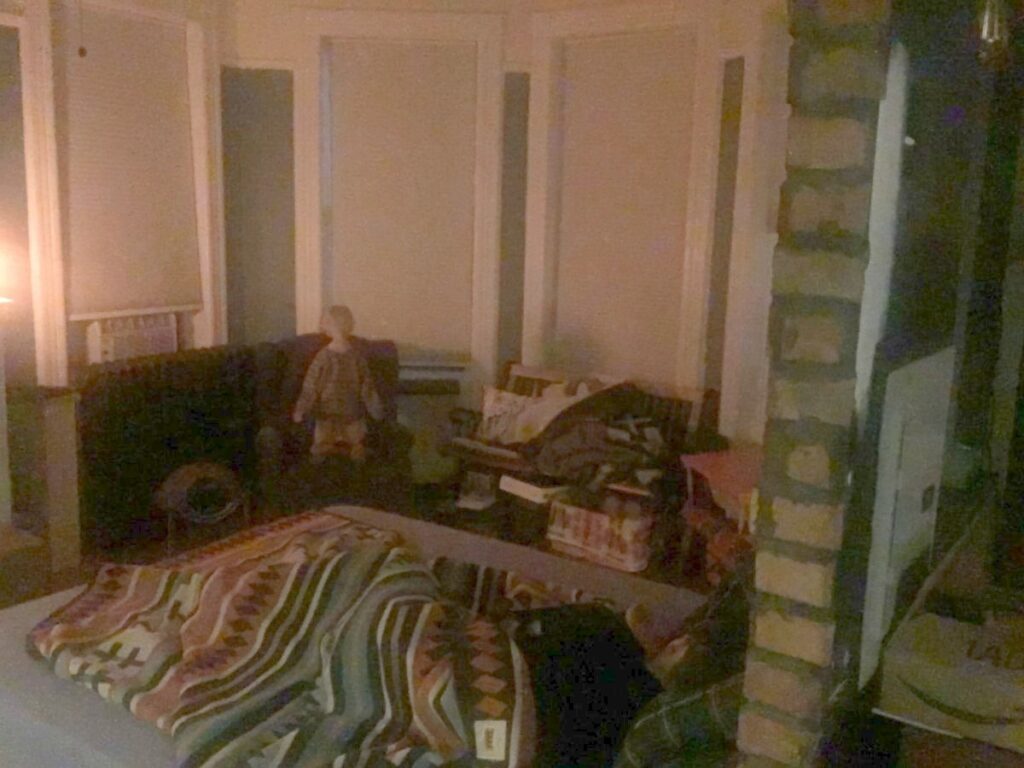
And this:
Brightened:
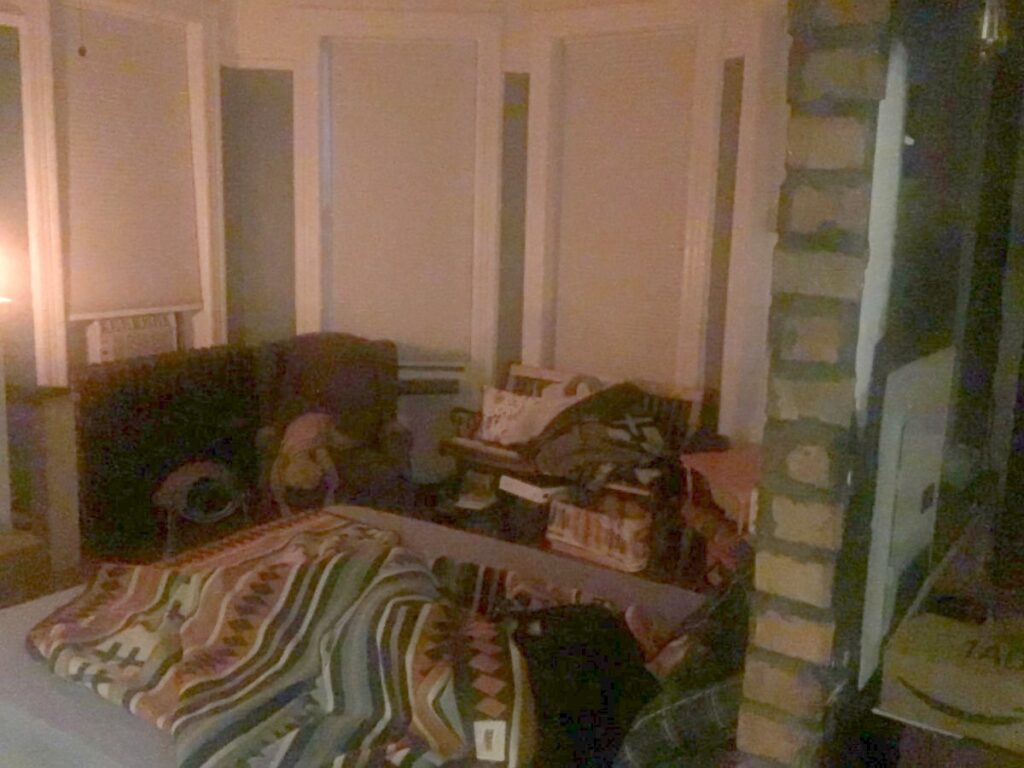
Then he disappeared for about 15 photos (or, roughly 15 minutes). The next time he appeared, he had gotten closer:
Brightened, and also with David highlighted, because he’s kind of hard to see:
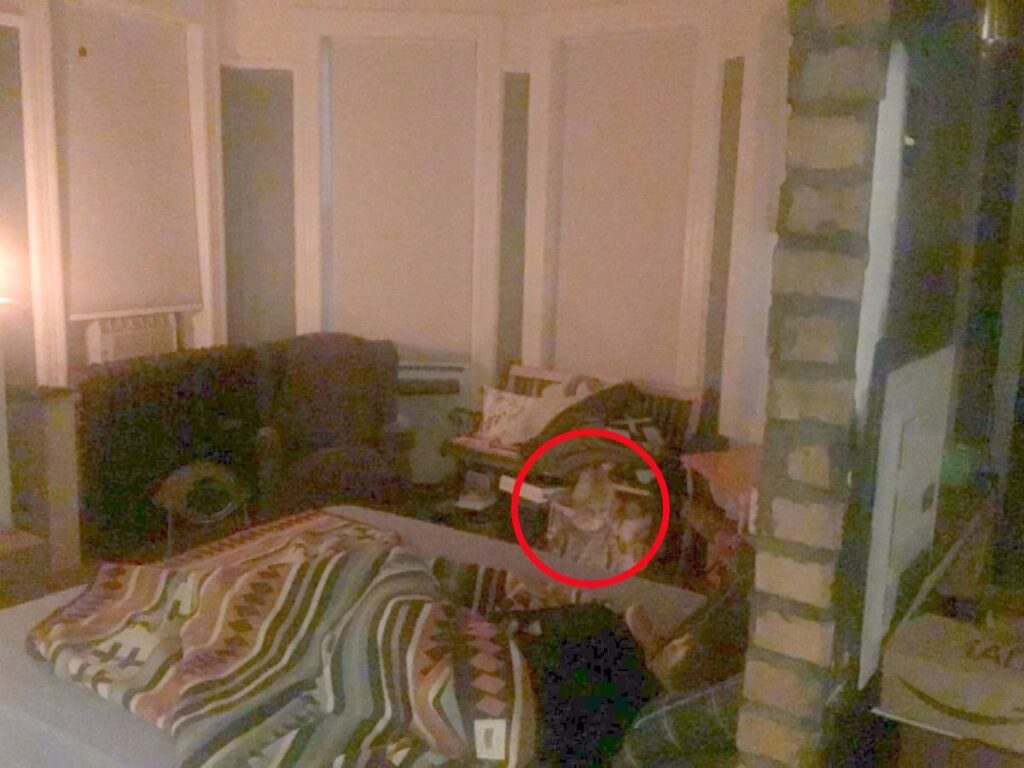
He kept getting closer, too:
Brightened:
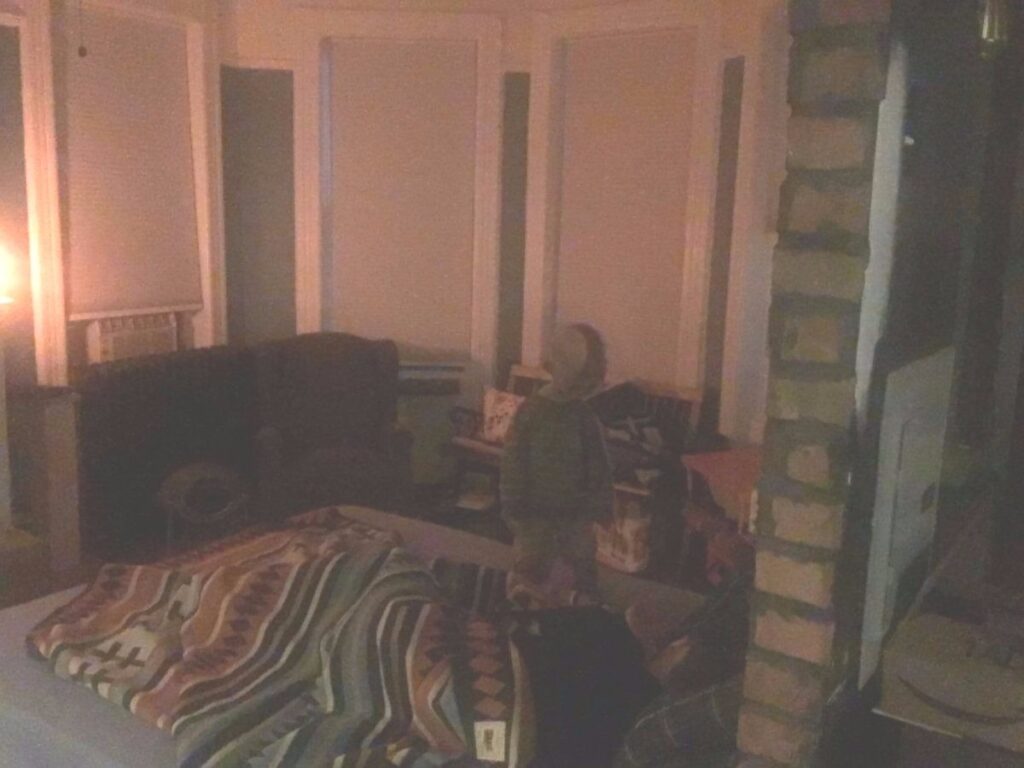
And then this:
Looks like David knows he’s being filmed. Brightened:
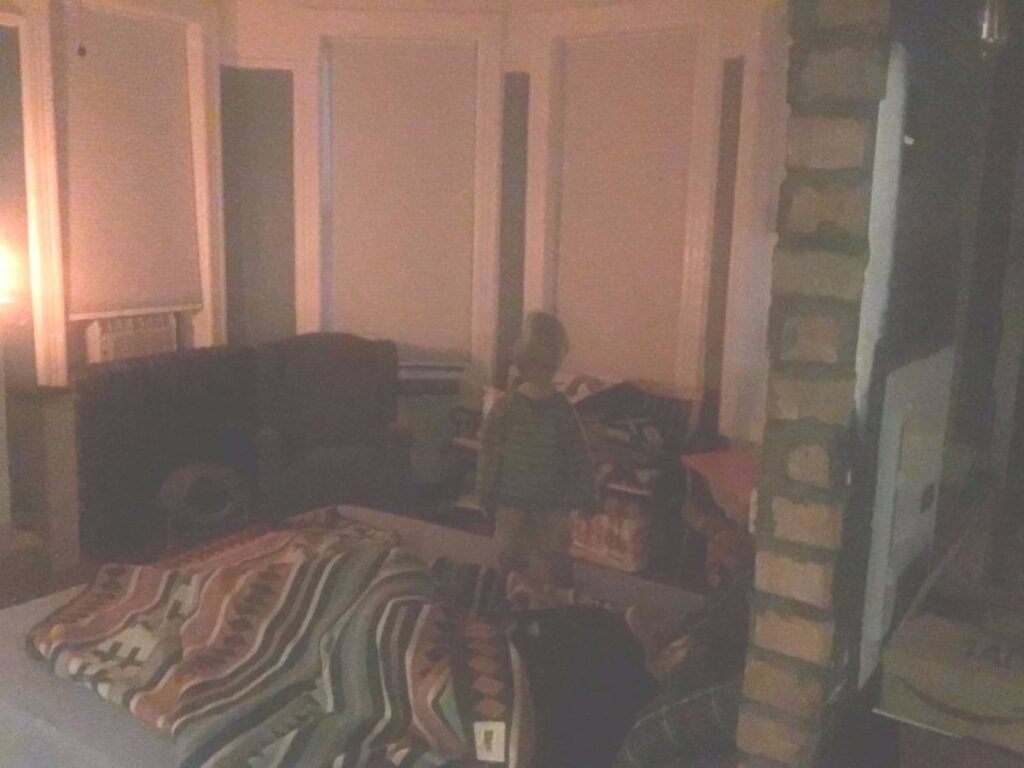
Then he disappeared again… until the very last photo on Ellis’ camera roll:
And, as this GIF a follower made suggests, David may have actually moved the camera in that last shot:
The pictures in and of themselves aren’t anything we haven’t already seen in this story; Ellis has come back to this technique and this context a few different times. What is interesting to me, though — and I’ve made this observation elsewhere before, so forgive me if you’ve already heard my thoughts on the matter — is the very fact of the repetition. At this point, we’ve seen this setup three different times in the story: Once at the beginning; once during the Nov. 6 update; and a third time here. What this suggests to me in terms of the story’s structure is that the original dream Ellis had — the one he recounted in the very first installment of the story — is meant to be a sort of premonition. As such, I wonder whether the climax of the whole thing is going to come back to it yet again, with the resolution showing us what we haven’t seen yet: That is, what happens when David actually reaches Ellis on the bed.
Of course, it may not go that way — but it’s possible (plausible, even) that it might. And I wonder, therefore, if the end might be arriving soon.
Not super soon, though, because it was a full three weeks before Ellis tweeted another substantial update. He did tell followers on Dec. 20 that he was heading to Montana, where he’s from, to visit family for the holidays; it wasn’t until late on Jan. 2, though, that he told us what had happened in the intervening weeks.
It was, as they say, a doozy.
Home For The Holidays
Ellis said in his Jan. 2, 2018 update that as soon as he got to Montana, he felt better than he had been feeling for a while almost immediately — both “less tired” and “less foggy.” He thought — hoped — his improved state of being suggested that David would not, as he’d previously suspected, follow him wherever he went. That’s what he said had stopped him from moving this whole time: The possibility that, if he moved, David would just follow him. He’d already done it once before, right? When Ellis moved from the downstairs apartment to the upstairs one? What evidence was there he wouldn’t just do it again?
But the weird feelings returned in short order — and what’s more, Ellis said he started feel like there was something lurking outside the bathroom window when he got up in the middle of the night. The first time he got that feeling, he found animal tracks outside the next day:
But the second time… it was human tracks:
(I’ll be honest: I can’t actually tell how big or small they are from this picture, so I’m taking Ellis at his word that they were small. The observation suggests they were child-sized — and therefore David-sized.)
The tracks disappeared into a ditch in the backyard, leaving Ellis with no idea what to do. In the end, he just battened down the proverbial hatches; he was, he said, “too scared to leave my room” during the last few nights. “If it had been David out there in the snow,” he wrote, “it meant that he could follow me anywhere. No matter where I moved, he could find me. I felt helpless.” The implication is that David isn’t just haunting Ellis’ apartment; he’s haunting Ellis himself.
Things got worse when Ellis got back to New York on Dec. 27. “I can still feel him at night,” he said. “Watching me from different corners of my room. Always getting closer, and waking up right before something happens.” Ellis has been using the automatic photo app he downloaded in the last update, but mostly come up empty — until something that happened the evening of Jan. 1: During a “particularly bad” night full of nightmares and feeling sick, Ellis “dreamed that David was hovering in the corner by the ceiling, far off the ground.” His mouth was moving unnaturally quickly, and Ellis couldn’t make out what he was saying. Paralyzed—as he often is in his Dear David dreams — Ellis could only look up at David… who suddenly dropped from the ceiling. “I felt this huge pressure crash into my chest,” Ellis wrote. “I woke up gasping, the wind completely knocked out of me.”
There was nothing else in the room with him — but when he checked his phone, his photo app had captured this picture just moments before he had woken up:
Brightened:
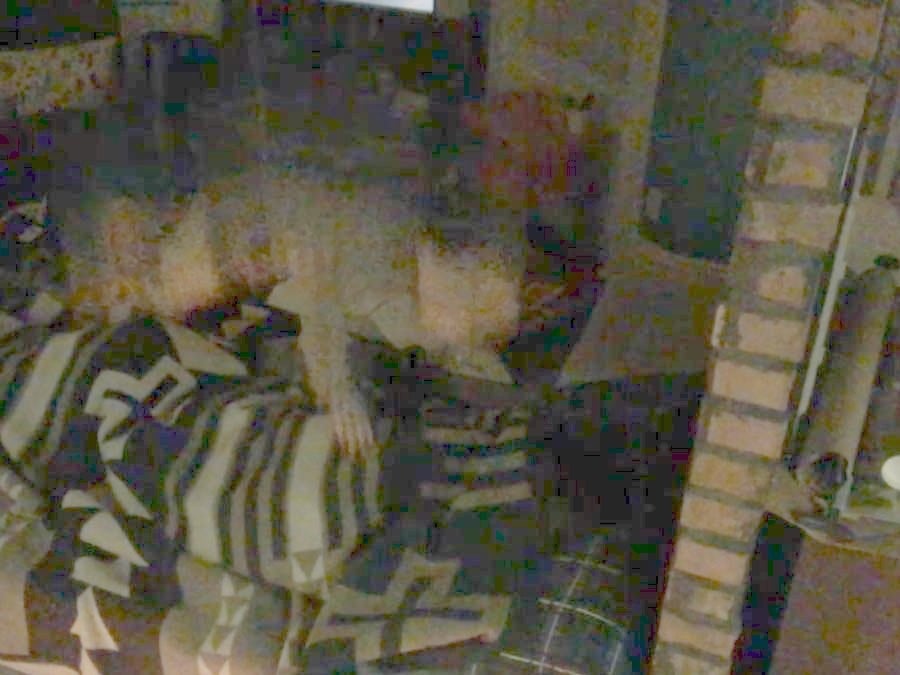
What I’m curious about now is this: The previous update seemed to have established that David knew Ellis was taking pictures of him. Is that really the case? And if so, does his absence in most of the recent images mean that he’s figured out how to dodge the camera? Related: If he’s got control over whether or not he’s caught on camera, why would he allow that last picture to be captured? Is it a scare tactic?
For what it’s worth, I don’t believe that David is looking for help — and neither does Ellis. He’d previously commented on Dec. 12, “People tweet at me a lot saying he might just need help, but I’m certain that’s not the case. Every time he shows up, I feel a palpable sense of malice.” In this context, David selecting which images he appears in and using it as a scare tactic would make sense — but that’s mostly speculation on my part.
Where Do We Go From Here?
In any event, I think it’s clear that wherever the story is going, it’s ultimately going to be a face-off between David and Ellis. If this is indeed the case, the question is about who’s going to win.
Right now, it looks like David is poised to capture victory — and honestly, that’s the ending that I think would provide the most satisfying ending within the confines of the universe the story has created. It does, however, have some interesting implications; If David “wins” — which could manifest in anything from David killing Ellis to taking over his body — and Ellis continues to use his regular Twitter account, it might force him to reveal, finally, that the whole thing was a hoax; if he doesn’t, then he’ll be left with a really weird situation to work around for literally the rest of his online life. If he’s dead, how is he still tweeting? If David is meant to be doing the tweeting, do we have to work within that narrative framework every time we look at Ellis’ Twitter page, regardless as to what he’s tweeting about? Do we just… ignore everything that’s been unfolding and resuming viewing the Twitter account as we did before the story started?
All of those situations are awkward, imperfect, and unsatisfying. That doesn’t mean that we won’t end up dealing with them, but from a storytelling perspective, it wouldn’t be ideal; it leaves loose ends that kill the reality the narrative built.
The easier solution, of course, would be to have Ellis “win” by banishing David or something like that; then Ellis would be able to resume his regular Twitter activity without needing to account for his own death or the continued existence of a malevolent spirit. It would, however, be less satisfying in terms of the contained narrative arc.
But, well… you can’t have everything. And hey, maybe there’s something else entirely going on here — and maybe we’re not even anywhere near the end. What I do know is that Ellis won’t be able to keep the story going forever; eventually, he’ll have to draw it to a close, and ideally, he’ll do that before he runs out of steam. (If Lost taught us anything, it’s that having an ending you’re actively working towards is really, really important.)
In the meantime, though, I’ll keep following along. You can, too — follow Ellis on Twitter here and on Storify here.
David is waiting.
***
Follow The Ghost In My Machine on Twitter @GhostMachine13 and on Facebook @TheGhostInMyMachine. And don’t forget to check out Dangerous Games To Play In The Dark, available now from Chronicle Books!
[Photos via PublicDomainPictures/Pixabay; Adam Ellis/Twitter, remixed by Lucia Peters]